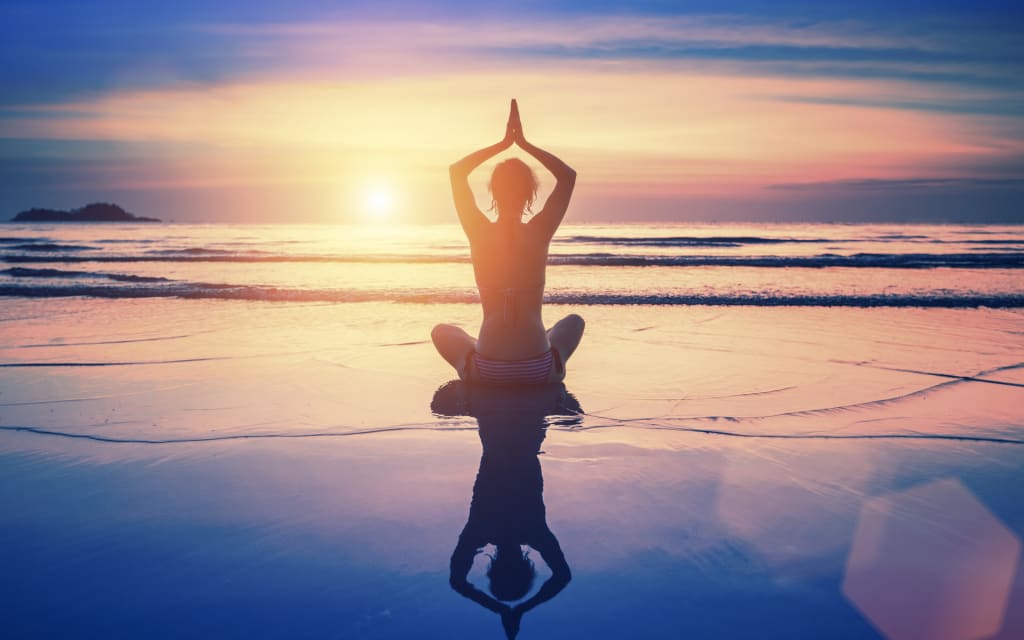How to Meditate for Beginners
Learning how to meditate for beginners can introduce life balance and reduce stress.

Meditation is an age-old practice that allows us to achieve balance of body, mind, and spirit. Not only can it help boost our immune systems, but many studies have also shown that meditation, mindfulness, and deep relaxation can reduce stress, improve cognitive focus, and affect emotions in many positive ways.
The practice of meditation helps clear our minds of the clutter of day-to-day life, and replaces it with harmony and inner peace. Too often in our lives we are consumed with what is wrong and how things could be better. Meditation helps us steer that focus away from why things are not going exactly as we'd like them to, and teaches us to simply observe what is. In doing so, we can worry less about things being a little uncomfortable and find peace in reality.
Some people steer clear of meditation because they envision the stereotypes of monks in saffron robes with their index fingers connected to their thumbs and chanting “Hare Krishna” repeatedly. While chanting mantras is one style of meditation, there are many different ways in which people meditate. Some people create art or music, dance, take long walks through the woods, practice yoga, tai chi, or other forms of martial arts, and others chant mantras. And, of course, some sit on the cushion, eyes closed, and focus on their breath. We'll talk about this style of breathing meditation most, since it is the one you are probably most curious about.
What Do I Need to Meditate?

Photo via The Blue Room
Create a conducive environment. While it's possible to meditate anywhere, it's best in the beginning to create a quiet, distraction-free zone. An ideal setting would be a separate room in your house where no one will disturb you. If you live with others, let them know that you will need them to limit their noise for the duration of your meditation. Turn off all electronic devices— including your cell phone. Dim the lights before you begin, as bright lights can make it difficult to bring your awareness inward.
Wear comfortable clothing. Again, you'll want to limit your distractions as much as possible. This includes tight, restrictive clothing that might pinch or pull on you. Choose loose, breathable clothes or something in which you might sleep. Also, make sure you'll be warm. There's nothing more distracting than chattering teeth. You'll have enough chatter going on in your mind to keep you occupied.
Choose a comfortable seat. You can use a circular meditation cushion (a zafu). When sitting on the ground without a backed chair, you'll be less likely to slouch or fall asleep. However, that doesn't mean you can't sit in a chair with a back. Just make sure you remain as erect as possible.
Buy a timer. Don't think that you won't be tempted to check the clock to see how long you've been meditating. You'll have no clear idea of how long you've been sitting, and you will most definitely want to check the time. Set an alarm for the amount of time you want to meditate.
How Do I Meditate?

Decide on how long you will meditate. Start small. Three to five minutes is ideal for the beginner. As you progress in your practice, you might consider increasing the time, but for now, keep it short. You don't immediately run 26-mile races without training to run a mile first.
Choose how you will be seated. Whether you choose to sit on the ground with a cushion or in a chair, maintain an upright posture. Not only is this conducive for concentrating on your breath, but it will also keep you from falling asleep during longer periods of meditation. Don't worry about the position of your legs—cross-legged, out in front of you, or underneath you. The important thing is to have an upright posture.
Set your timer. Once you've chosen a duration, set your alarm for three to five minutes. Seasoned meditators will tell you that it's nearly impossible not to want to check the time during the beginning stages of your practice. Limit that impulse by having a clock tell you when it's time to get up. Start working your way up to half-hour or longer sessions once you start feeling comfortable with your practice.
Breathe through your nose. Keep your mouth closed, both inhaling and exhaling through your nose. Relax your jaw muscles. Begin to relax everything.
Close your eyes. As stated earlier, there are many ways to meditate, and some methods require the eyes to remain open (such as Zen meditation). However, for this practice, closed eyes will limit visual distraction and allow you to focus on your breath.
Focus on your breathing. Sometimes it's easy to forget that we're breathing, but what better positive focus than that which gives us life? Without it, we're toast, so if we know we're breathing, we know we're alive. It can help to notice our breath if we begin taking deep breaths. Gradually, begin to soften the breath. Notice how it feels as it moves in and out through your nose. Observe how it fills your lungs as you inhale, and how it leaves your chest as you exhale. Notice its sound. Really try to observe everything about the breath, without judgment—from the easiest things to the most subtle details.
Simply observe the breath. Once you've given it your attention, become less analytical and allow yourself to just be with the experience. The ultimate goal is to be present in this specific moment. You don't have to force yourself to breathe. The body does it for us, and because we don't have to tell our body to breathe, we can simply experience each passing breath with our senses. Watch, listen, and observe your inhale until your body naturally moves into an exhale. It's like people-watching, except breath-watching.
Don't worry if your mind wanders away from breathing. THIS is what meditation is about. Beginners always think they're bad at meditating or that they're not doing it right because their thoughts are all over the place. This is why it's called a “practice.” Even the most experienced meditator will find him/herself thinking about something else—the course of events earlier that day, the answer to a question they couldn't answer a year ago, or the the mosquito buzzing around their head. Acknowledge that your mind has drifted to another place and come back to your breathing. Those thoughts are not your mind. The fact that your mind has acknowledged them proves that they aren't. They are, in fact, outsiders to your mind, and you have the ability to let them fall away. Thoughts will come back up. Continue coming back to your breathing again and again.
Tips for Successful Meditation

Photo via The Huffington Post
- Choose the time when you feel most ready to meditate and when you can find an environment without distraction.
- Don't meditate with an empty stomach. It's pretty difficult to achieve inner peace when you're “hangry.” The rule of thumb is to meditate with a stomach 2/3 full. If you're hungry, have a small bite. If you're overly full, you may get drowsy.
- In the beginning of your practice, you may want to count your breaths. Square-breath is a common technique to bring focus and control to the breath. As you inhale, count to four, hold your breath for a four-count. As you exhale, count to four, and again hold your breath for a four-count. Repeat this process. You can change this to your comfort level. For example, if it's not easy to hold your breath for a four-count, just hold it for one second. Four in, hold for one, four out, hold for one. Repeat.
- If you need a little assistance, you can try finding a group meditation to attend. These are often guided meditations with one person giving instruction for all that attend. This can be very helpful, as you will be assisted throughout the process. You can easily find guided MP3s on the internet.
- Investigate movement forms of meditation such as Tai Chi, walking meditation, and more.
- Breathing is one thing to focus on, but experiment with scanning your body or focusing on a part of the body for a period of time. In the same way that you observe your breathing objectively, focus on things like pain or discomfort in certain areas of the body. While it may not go away, it may help in pain management.
Now you're ready to begin meditating. Don't become daunted by how difficult it can sometimes be. With practice and patience, you will start to experience a more relaxed state of being—a balanced and focused mind.
About the Creator
David McCleary
Holistic health practitioner. Believes in using natural remedies over traditional medications whenever possible. Volunteers at a recycling plant.






Comments
There are no comments for this story
Be the first to respond and start the conversation.